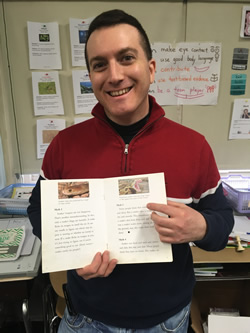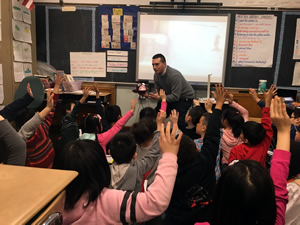|
|
For nearly two decades, Scott Freiberger has been an educator, instructional mentor, and teacher trainer in the United States and East Asia. He has earned three master’s degrees and is certified in TESOL (K–12) in New York and Florida (with a Reading Endorsement) and in New York as a school/district leader.
TESOL’s Nancy Flores asked Scott some questions about the path to his current career, how context has affected his classroom practice, and his upcoming TESOL 2018 convention session, “Enhancing Curriculum Access and Classroom Equity Through Academic Language.”
Nancy Flores (NF): Why did you become an English language teacher?
Scott Brian Freiberger (SBF): I would first like to take this opportunity to sincerely thank the TESOL Awards Professional Council for this prestigious award. I am truly honored, deeply humbled, and very appreciative. I had worked my way through Queens College of CUNY by teaching English as a second language (ESL) and Test of English as a Foreign Language (TOEFL) classes and as a campus tutor for the Office of Special Services, and I felt a deep sense of accomplishment empowering special needs students to succeed. Working as a teacher and teacher trainer in the Republic of China and Japan for 10 years then instilled a deeper appreciation for and understanding of second language acquisition. I am very grateful for the superior instruction I received at the University of Central Florida MA TESOL program. My terrific trio of dedicated thesis advisors, Dr. Kerry Purmensky, Dr. Florin Mihai, and Dr. Keith Folse, whom I refer to with colleagues and practitioners in the field as “the dynamic dream team,” inspired me with expert advice and sound academic guidance. The targeted TESOL training I had received at the University of Central Florida provided a solid foundation upon which to build critical cognitive and instructional skills and enhance my overall pedagogy.
I was also greatly encouraged at Seminole State College of Florida by my sensational supervisor, Mr. William Elshoff, while teaching English to speakers of other languages (ESOL) and English for academic purposes (EAP) courses. During this time, I also had the privilege of teaching ESOL and reading to at-risk youth at a Title I high school. I currently work with a terrific team of dedicated teachers and supportive school leaders, such as Principal Victoria Rice and Assistant Principal Patrick Foy at P.S. 20Q John Bowne Elementary School of Global Studies in New York City. Motivating at-risk youth to succeed continues to inspire me. My classroom has become a haven for learning, and I actively encourage students to endeavor in education and conceive of their schooling as a springboard to a better life.
|
|
NF: You previously taught in the Republic of China and Japan. How has teaching in those contexts affected your classroom practice?
SBF: I am very fortunate to have had the opportunity to work as a teacher and teacher trainer in East Asia for 10 years. While working abroad, I developed a profound respect for languages and cultures other than my own, and recognized that learning a second or foreign language may also encapsulate cultural and religious beliefs. Teaching abroad provided a unique lens in which to reflect on my practice. I learned that methodology choice may depend on sociocultural factors, such as peer interaction and classroom environment; students’ competencies and needs; and for younger learners, administrative and parental concerns. Remaining flexible, open-minded, and good-natured also transcends cultural borders.
NF: What do you think is the role of the English language teacher in the community?
SBF: The community where I teach in New York City is diverse and dynamic, and I am fortunate to have the opportunity to use my language skills to assist administrators, educators, and support staff to engage families and empower students to succeed. Many children in the community do not have opportunities to practice speaking English outside of school, so I challenge them to fathom the importance of bilingualism. I emphasize to parents, guardians, and family members that students should not lose their native languages while learning English, and that students’ mother tongues could be used as a scaffold to better decipher meaning, compare language nuances and structure, and ultimately augment and support learning English as a new language. Fortunately, my language skills and curricula knowledge have been a valuable asset during parent/student events, and I am honored to assist with translation during parent meetings for administrators, educators, and members of the support staff.
NF: You have an upcoming convention session, “Enhancing Curriculum Access and Classroom Equity Through Academic Language.” Can you give us a preview? How did you arrive at that topic?
SBF: Providing a solid foundation in academic language not only increases students’ communicative competence, but it also improves vocabulary knowledge and verbal expression (Freiberger, 2017). Academic language should therefore be carefully considered to motivate and improve students’ lives in direct, tangible ways (Nushi & Jenabzadeh, 2016). To help spark students’ enthusiasm, educators may want to consider infusing academic language via differentiated, interactive learning activities. For instance, in addition to referential classroom posters and extensive word walls, students could bring academic words to life by completing graphic organizers depicting colloquial English on one side and academic English on the other (Breiseth, 2014; Freiberger, 2017). Vivid visuals and delineating English by subject, such as language arts or science, may also help. Bilingual students could even translate high-level academic English into their native languages to instill confidence and improve classroom communication for nonnative speakers.
Infusing academic language into classroom dialogues on a more frequent basis should also, in turn, translate to “multiple data sources that measure stronger academic growth levels across grades, more self-assured educators and assenting, amicable administrators, and sensational students coupled with motivated key constituents who take pride in all student accomplishments” (Freiberger, 2017). Provide ample opportunities for students to engage in meaningful collaboration to master academic language, the language of power and prestige (Hill & Miller, 2013). I was honored to be entrusted by the principal to gather data and document student progress for the district’s select Principal’s Focus Group, and I continue to research best practices in bringing academic words to life for nonnative English speakers.
NF: What advice would you give other TESOL professionals who are just beginning their careers?
SBF: Pursue your passions and excellence will follow. For example, you may be sagacious with statistics, but if you enjoy crunching your abdominal muscles far more than crunching numbers, chances are you will not be terribly successful in the long term if you pursue a career as a statistician. The most successful individuals are passionate about what they do and persevere in the face of adversity. Also, real empathy in action means putting yourself in the proverbial shoes of others. Think about the best teachers you encountered throughout your academic career. Were they pessimistic and tedious hum-drum lecturers or were they lively, positive educators who provided ample opportunities for collaboration and metacognition? Tap into students’ interests to spark creativity and motivation, and create a more engaging, enjoyable educational experience for everyone. Finally, continually strive to upgrade your knowledge and skills, and never stop believing that you can be the change that you seek to inspire in others. I sincerely wish everyone in our field the very best of luck and success as we pursue excellence in education.
References
Breiseth, L. (2014). Academic language and ELLs: What teachers need to know. Retrieved from http://www.colorincolorado.org/article/academic-language-and-ells-what-teachers-need-know#h-introduction
Freiberger, S. (2017, July 17). Academic language matters. Language Magazine. Retrieved from https://www.languagemagazine.com/2017/07/academic-language-matters
Hill, J. D., & Miller, K. B. (2013). Classroom instruction that works with English language learners. Retrieved from http://www.ascd.org/publications/books/114004/chapters/Academic-Language.aspx
Nushi, M., & Jenabzadeh, H. (2016, Summer-Fall). Teaching and learning academic vocabulary. California Linguistic Notes, 40(2). Retrieved from http://english.fullerton.edu/publications/cln/clncurrentissue/CLN_Nushi_Academic%20Vocabulary%20.pdf
|
Download this article (PDF) |
Nancy Flores is the membership coordinator at TESOL International Association. She has been with the association for 9 years and helps to assist members and manage membership-related projects. Originally from Honduras, Flores is a fluent Spanish speaker and has a bachelor’s degree in psychology from George Mason University.
| Next Article |

